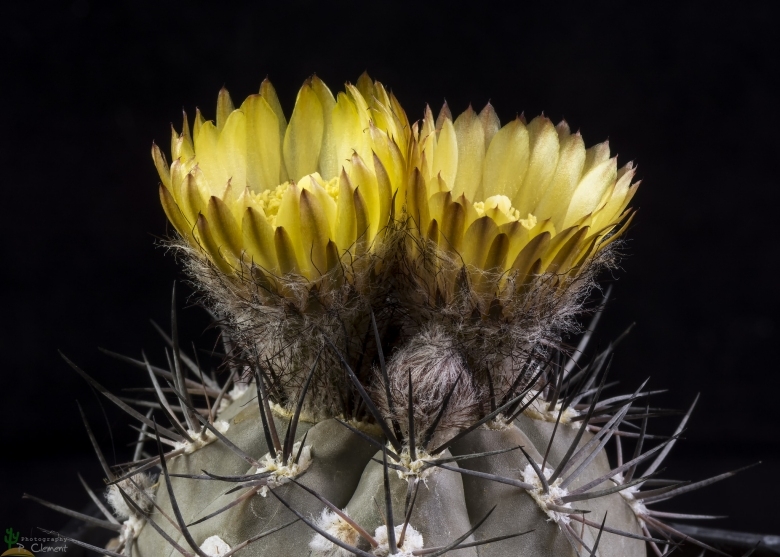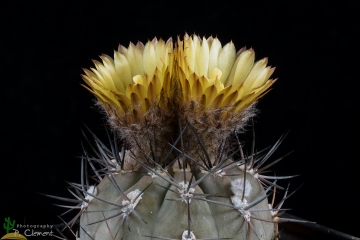




Your support is critical to our success.
Accepted Scientific Name: Eriosyce vertongenii (J.G.Lamb.) D.R.Hunt
Cactaceae Consensus Init. 3: 25. 1997

Origin and Habitat: Baños La Laja on the Sierra Villicum (San Juan), Argentina.
Synonyms:
- Eriosyce vertongenii (J.G.Lamb.) D.R.Hunt
- Pyrrhocactus vertongenii J.G.Lamb.
Description: Eriosyce vertongeniiSN|3026]]SN|3024]], best known as Pyrrhocactus vertongeniiSN|3027]]SN|3025]], is a mall somewhat squat cactus usually unbranched, with greys green or greenish brown stems and yellow to salmon flowers to 4 cm long. This choice, slow-growing cactus is considered to be closely related (if not the same) with Eriosyce villicumensisSN|3024]]SN|3026]] (Pyrrhocactus villicumensisSN|3025]]SN|3027]]). Lambert named the latter but it had already been described by Rausch as villicumensis. Seems Rausch had forgotten his original habitat location and mislead Lambert. They are both described as north of San Juan on the Sierra Villicum.
Derivation of specific name: vertongenii For Dr. Herman Vertongen (fl. 1995), Belgian cactus enthusiast.
Stem: Solitary except in case of injury to the growing tip, flattened to subglobose, greenish-grey to greenish brown, to 3.5 cm tall and 5.5 cm across. Older plants may occasionally grow larger, but without ever exceeding the size of a fist (about 10 cm). Apex slightly depressed, woolly and with spines.
Roots: Diffuse.
Ribs: 8-13, clearly separated by vertical furrows forming small rounded chins only in the upper part of the plant. The transverse furrows are short.
Areoles: Oval, relatively large 5-6 mm long and 4-5 mm wide, at first covered with yellowish white wool, becoming dirty white and more or less naked eventually.
Central spine: 0-1, pointing upward.
Radial spines: 5-9, in 2-4 lateral pairs with an odd spine directed downwards, stout, round in cross section, needle-like, acuminate, more or less erect, slightly curved, with dark grey to black tips (Completely black in the wet state), short, not more than to 15 mm long .
Flowers: Borne near the apex on young areoles, funnelform, light yellow to salmon, to 4 cm long and in diameter. Tube conical, brown olive, with dark brown scales bearing a blackish mucro (a fine point), trimmed with abundant long fluffy wool and 3-5 black silk-bristles, up to 10 mm long in the upper part of the tube.Outer perianth-segments lanceolate and mucronate, pink salmon with broad median brown line.
Inner perianth-segments more broadly lanceolate or spatulate mucronate, light yellow with a pink salmon median line and carmine mucro. Throat and filaments greenish-yellow. Anthers sulphur yellow. Style light pink. Stigma lobes10 white.
Fruits: Elongate to barrel-shaped, up to 17 mm high and 14 mm in diameter, tannish to blackish, covered with black-tipped scales with white wool and blackish silky bristles, wind dispersed, dry, dehiscing by basal pores.
Seed: Shaped like snail shell, about 1.7 mm long and 1 mm wide.
Bibliography: Major references and further lectures
1) Fred Kattermann “Eriosyce (Cactaceae): The Genus Revised and Amplified” David Hunt, 1994
2) J.G. Lambert Ir. A.I.Gx. “Cactus d’Argentine” 2ème édition Revue et complétée, Concordia-Roeselare., 1997
3) Sara Oldfield “Cactus and Succulent Plants: Status Survey and Conservation Action Plan” IUCN, 01/Jan/1997
4) Edward Anderson “The Cactus family” Timber Press, Incorporated, 2001
5) James Cullen, Sabina G. Knees, H. Suzanne Cubey "The European Garden Flora Flowering Plants: A Manual for the Identification of Plants Cultivated in Europe, Both Out-of-Doors and Under Glass" Cambridge University Press, 11/Aug/2011
6) David R Hunt; Nigel P Taylor; Graham Charles; International Cactaceae Systematics Group. "The New Cactus Lexicon" dh books, 2006
7) Urs Eggli, Leonard E. Newton: “Etymological Dictionary of Succulent Plant Names” Springer, Berlin/Heidelberg 2010
8) Succulenta. 74(6): 271, 1995.
9) Cactaceae Consensus Initiatives. 3: 25.1997.
10) Eriosyce (Pyrrhocactus) vertongenii - Page 2 - BCSS – Forum http://forum.bcss.org.uk/viewtopic.php?t=155897&start=10

Pyrrhocactus vertongenii (Eriosyce vertongenii) Photo by: Peiffer Clement
The gallery now contains thousands of pictures, however it is possible to do even more. We are, of course, seeking photos of species not yet shown in the gallery but not only that, we are also looking for better pictures than those already present. Read More...
Cultivation and Propagation: It is an extremely xerophytic, summer-growing, species, adapted to very dry soils. Despite its provenance it is not particularly difficult to cultivate, but quite susceptible to over-waterings and rot prone if kept in a non-ventilated place.
Growth rate: Slow-growing.
Soil: It requires a very fast draining drying open mineral, sandy-gritty cactus composts. Provide a very good drainage.
Exposure: It is suited for sunny-brightly exposure, but can tolerate light shade. However it will do its best only with lots of sun and become stressed with inadequate light which could result in poor growth and unnatural shape. It has a good heat tolerance.
Watering: Water regularly in summer, but do not over-water and keep it completely dry during winter. Mature individuals easily rot and die especially after transplanting so be extremely cautious with watering. Keep dry in winter or when night temperatures remain below 10° C. Water it less than average if in bigger pots.
Fertilization: Feed them once during the growing season with a fertilizer specifically formulated for cactus and succulents (high potash fertilizer with a dilute low nitrogen), including all micro nutrients and trace elements diluted to ½ the strength recommended on the label. They thrive in poor soils and need a limited supplies of fertilizer to avoid the plants developing excess vegetation, which is easily attacked by fungal diseases.
Special need: It is suited for airy exposures. Provide very good ventilation. Nearly all problems occur as a result of overwatering and poor ventilation, especially when weather conditions are dull and cool or very humid. They must have very dry atmosphere.
Hardiness: It likes warmth (recommended minimum winter temperature 5° C), but Hardy to at least -5°C (it can probably tolerate freezing temperatures down to -10° C for brief periods) It has a good heat tolerance.
Pests & diseases: These cacti may be attractive to a variety of insects, but plants in good condition should be nearly pest-free, particularly if they are grown in a mineral potting-mix, with good exposure and ventilation. Nonetheless, there are several pests to watch for.
- Red spiders: Red spiders may be effectively rubbed up by misting the plants from above.
- Mealy bugs: Mealy bugs occasionally develop aerial into the new leaves and flowers with disfiguring results, but the worst types develop underground on the roots and are invisible except by their effects.
- Scales, thrips and aphids: These insects are rarely a problem.
- Rot: Rot is only a minor problem if the plants are watered and “aired” correctly. If they are not, fungicides won't help all that much.
Propagation: Usually propagated from seeds (seldom produces offsets) or graft. The seeds can be sown in pots of fine, well-drained sandy soil, any time during the spring when temperatures are warm. Cover the seeds with a fine layer of grit and water from below with a fungicide to prevent damping off. For the 1-2 weeks cover the pots with a sheet of glass/clear perspex to keep the humidity levels high. Remove the glass and replace it with light shade-cloth and mist once or twice a day for the next two weeks after which most seeds should have germinated. From then on mistings can be reduced to every second and then every third day as the little plants grow. The seedlings should not be disturbed until they are well rooted after which they can be planted separately in small pots. Sometimes it is grafted to avoid root rot problems as plants grafted on an hardy stock are easy to grow and no special skill is required.
| Your Actions | |
|---|---|
| Back to Pyrrhocactus index | |
| Back to Cactaceae index | |
 |
Back to Cacti Encyclopedia index |
Privacy stantement - Terms and conditions - How to cite - About us - Feedback - Donate




